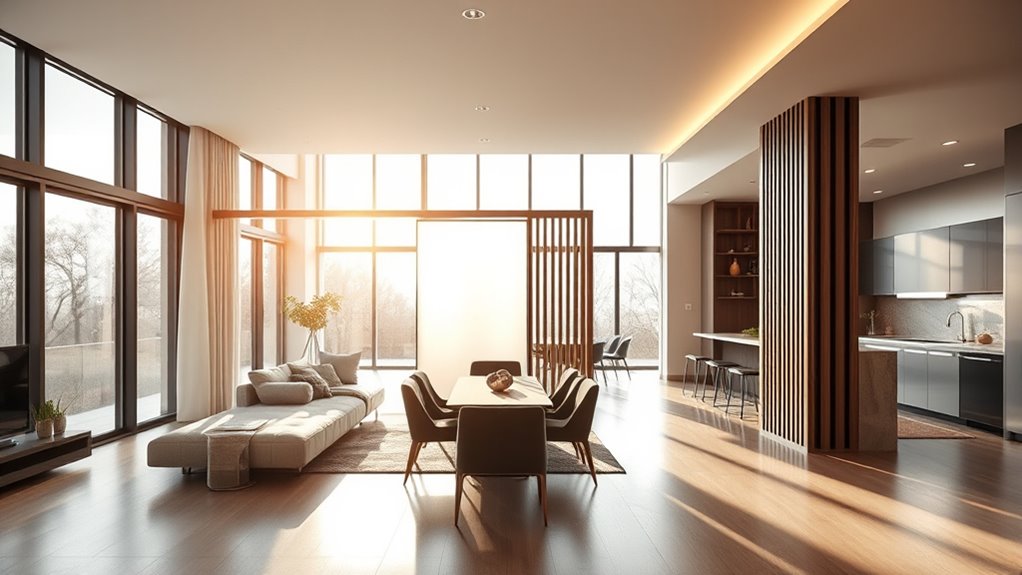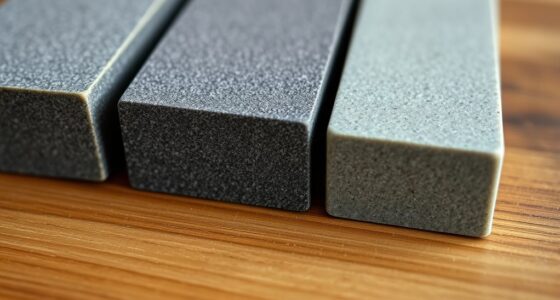The key to transforming any open floor plan is mastering furniture placement combined with strategic use of rugs and lighting. Position your sofas, chairs, and tables to create natural boundaries, and choose large area rugs that anchor each zone visually. Use layered lighting to highlight different spaces without physical barriers. Incorporate subtle changes in color, texture, and structural elements for added separation. Keep these techniques in mind, and you’ll discover more ways to create a cohesive, functional layout.
Key Takeaways
- Use large, strategically placed area rugs to visually anchor and define each zone within the open space.
- Arrange furniture into conversational clusters to create natural boundaries without physical walls.
- Incorporate layered lighting over different zones to emphasize separation and functionality.
- Add structural elements like beams, columns, or slight level changes for physical and visual division.
- Use decorative screens or movable partitions to create flexible, stylish boundaries that enhance flow.
Understanding the Power of Furniture Arrangement

Understanding the power of furniture arrangement is key to defining distinct zones within an open floor plan. Your furniture placement creates visual cues that help define zones without physical walls. By positioning sofas and chairs in conversational clusters, you naturally separate living areas from dining or workspaces. Using furniture pieces like bookcases or sideboards as buffers enhances this separation while keeping the space open. Orienting furniture to face focal points, such as a fireplace or entertainment center, guides the eye and emphasizes each zone. Incorporating rugs and lighting within your furniture arrangements further reinforces boundaries and adds aesthetic cohesion. Additionally, mindful furniture placement can maximize space and organization, and incorporating interior design principles can further enhance the flow and functionality of your layout. Being aware of self watering plant pots can inspire creative and practical solutions for integrating greenery into your zones, adding both style and vitality. Engaging curiosity about different layout techniques can inspire innovative solutions. With thoughtful placement, you can craft a functional, inviting space that clearly delineates zones, all while maintaining the openness and flow of your floor plan.
Using Area Rugs to Define Separate Zones
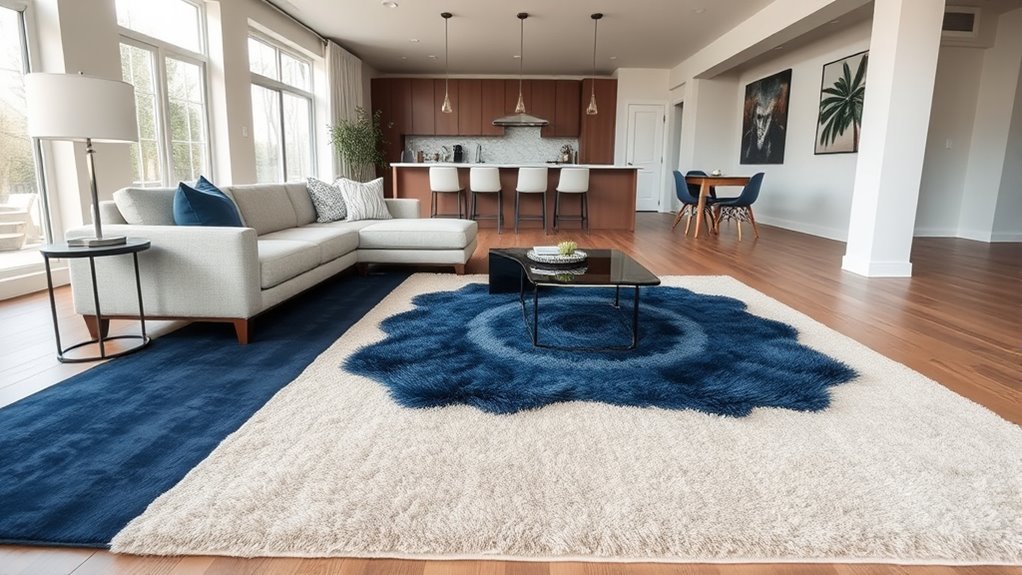
Choosing the right size and placement of area rugs is key to defining different zones clearly. A large rug that extends beyond furniture helps anchor the space and signals its purpose, while contrasting textures or colors can enhance visual separation. When you match rugs with your decor, you create a cohesive look that makes each zone feel intentional and functional. Incorporating textured or patterned rugs can further elevate the distinctiveness of each area. Additionally, selecting rugs that complement the warm color palettes and rustic materials common in farmhouse bedroom design can enhance the cozy, inviting atmosphere. Ensuring proper drainage and maintenance of your rugs can prolong their lifespan and keep the space looking fresh. Understanding production quantity variance can make a significant difference in achieving the desired spatial separation.
Choosing the Right Size
Ever wondered how to effectively define separate zones in an open floor plan? The key is choosing the right size of area rugs. Larger rugs, ideally 8×10 feet or bigger, work best for defining space because they visually anchor furniture like sofas and dining tables, creating clear boundaries. Using a single oversized rug in the main living area helps unify the space while subtly separating it from other zones. Contrasting colors or patterns can also highlight specific areas, making each zone distinct. Properly scaled rugs prevent visual clutter, maintaining an open, airy feel while providing clear visual boundaries. When selecting your floor coverings, aim for size and scale that complement your furniture and room dimensions, ensuring each zone is both functional and visually inviting. Incorporating appropriate rug sizes can enhance the overall flow and clarity of your open layout. Additionally, considering the contrast between rug patterns and room decor can further define each zone and add visual interest. Recognizing the importance of visual harmony ensures your space remains cohesive while defining individual areas effectively. Furthermore, selecting durable materials for your rugs ensures longevity and easy maintenance in high-traffic zones. To optimize space and comfort, adjusting rug placement based on the specific use of each zone can further improve your layout’s functionality.
Defining Functionality Clearly
How can you clearly define different zones in an open floor plan? Large rugs are your best tool for visual separation, creating distinct boundaries for each functional area. Placing a sizable rug under seating arrangements clearly delineates living or conversation zones without walls or partitions. Using different textures, colors, or patterns in rugs helps distinguish multiple zones, like dining versus lounging spaces. A single, well-chosen rug can anchor a specific zone, making it feel cozy and intentional while maintaining openness. Strategic positioning aligned with furniture and activity zones guides movement and enhances the spatial flow. This simple yet effective trick ensures each area has its purpose, visually separated without sacrificing the open feel you want in your floor plan.
Harmonizing With Decor
Using area rugs to define separate zones in an open floor plan helps create visual harmony and clear boundaries without walls. Select rugs that complement your decor to enhance the overall design. Different colors, patterns, or textures for each zone add visual interest while reinforcing the space’s purpose. A large rug under key furniture anchors each area and signals its function, whether dining or lounging. Proper placement, centered under main pieces, guides traffic flow smoothly. Layering rugs of varying sizes or styles can tie the spaces together while maintaining distinct zones. This approach ensures your open layout feels cohesive yet structured, making the environment inviting and stylish. Additionally, considering optimal angles for pinball machines can inspire creative ideas for arranging furniture and rugs to maximize space and functionality. Understanding space planning techniques allows for better zone definition and flow within your open floor plan. Incorporating decor elements that reflect your personal style can further unify the space. Paying attention to cost and budgeting helps you select rugs and decor that fit your budget while achieving the desired aesthetic. Being aware of Water Parks in nearby locations can also provide inspiration for creating lively and fun zones in your home or outdoor space. With thoughtful rug choices, you harmonize decor and design seamlessly, transforming your open floor plan into a beautifully organized space.
Strategic Lighting to Create Visual Boundaries
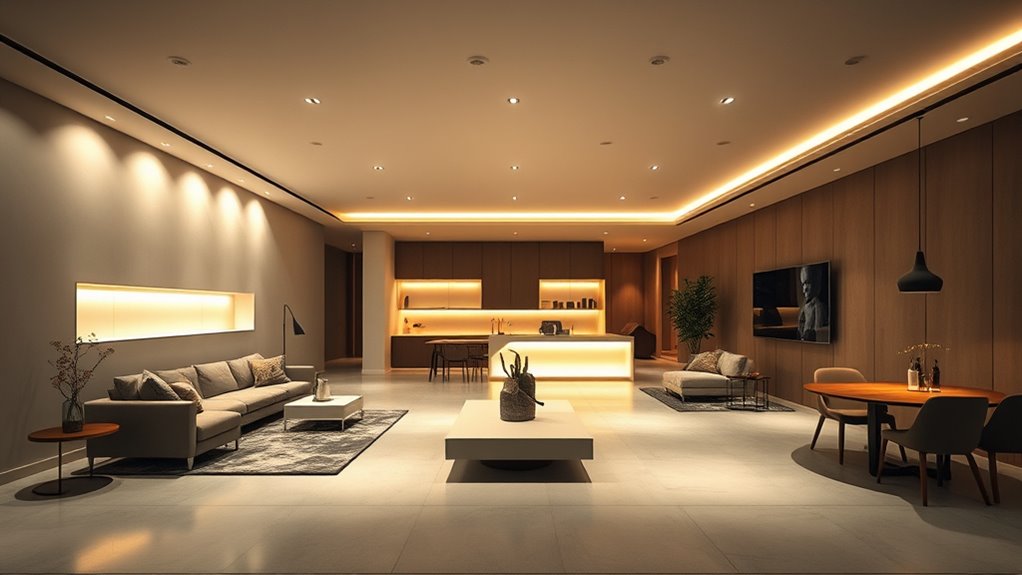
Strategic lighting plays a crucial role in defining separate zones within an open floor plan by drawing attention to specific areas. You can use layered lighting—combining ambient, task, and accent lights—to create clear visual cues that signal different functions. Proper placement of lighting fixtures over dining areas, seating zones, or workspaces enhances spatial boundaries without walls. Dimmable lights let you adjust ambiance, subtly shifting focus and activity zones. Incorporating contrasting lighting styles or color temperatures further reinforces separation, adding depth and interest. These techniques help your open layout feel cohesive yet distinct, guiding the eye naturally from one zone to another. By understanding interior design principles, you can more effectively craft a space that balances openness with defined areas and utilize lighting design techniques to enhance spatial perception.
Incorporating Color and Material Transitions
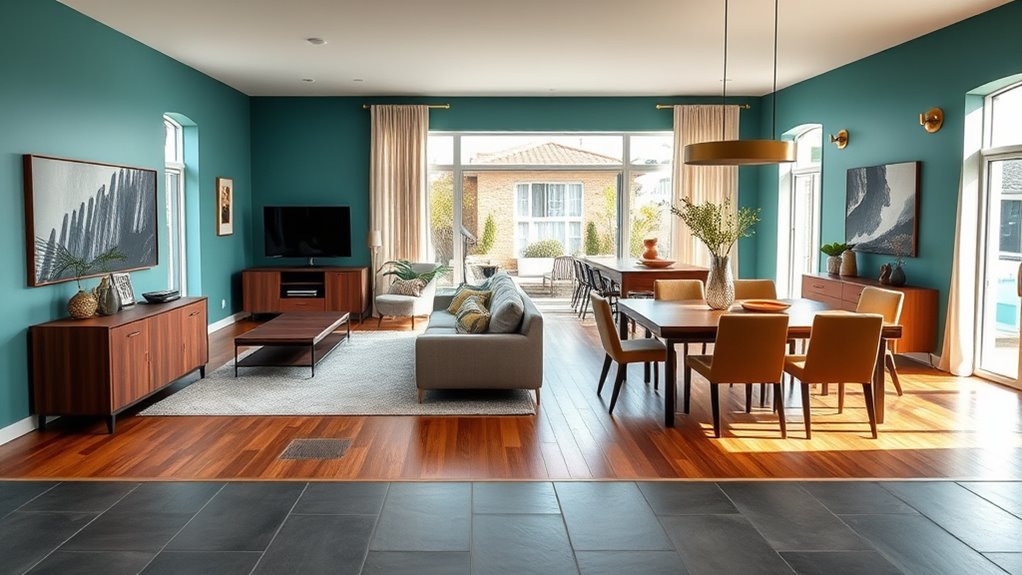
In an open floor plan, incorporating color and material shifts offers a simple yet effective way to define different zones without adding walls. By using color progressions and material differentiation, you create visual separation that highlights each space’s function. For example, contrasting flooring like hardwood in the living area and tile in the kitchen instantly delineates zones. Adding distinct wall treatments or wallpaper further emphasizes boundaries while maintaining overall design cohesion. Carefully planned transitions prevent visual clutter and ensure a seamless flow between spaces. Subtle changes in texture, finish, or color palette at transition points help define zones clearly. Additionally, understanding cybersecurity vulnerabilities can inform smarter smart home integration, ensuring safety while enhancing aesthetic delineation. This technique allows you to maintain an open, harmonious environment while subtly guiding the eye and creating intentional separation within your floor plan.
Utilizing Structural and Architectural Elements
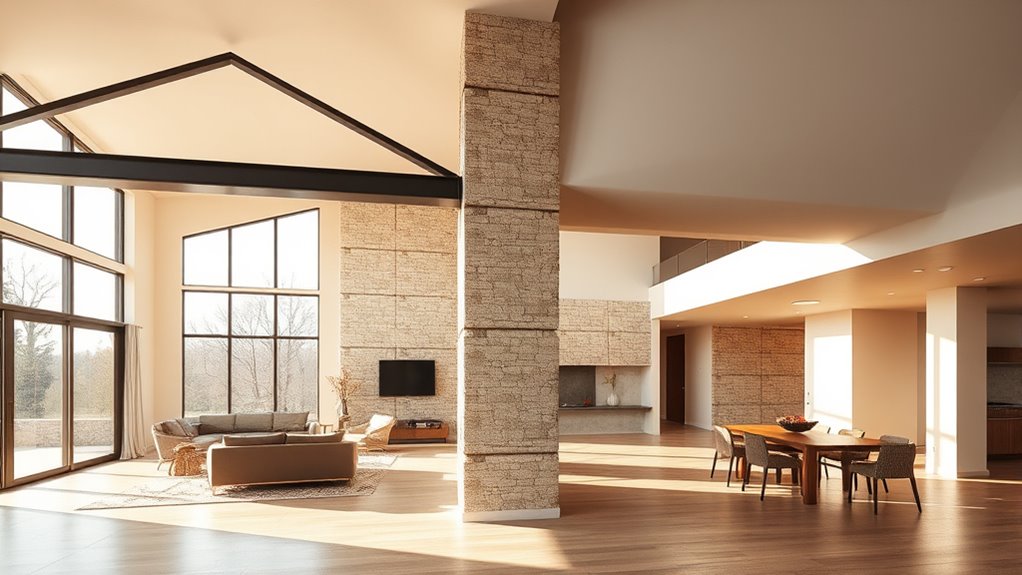
In open floor plans, structural and architectural elements serve as natural markers that help define different zones while preserving spaciousness. You can use exposed brick walls, beams, or columns as visual dividers, creating clear but unobtrusive boundaries. Architectural features like ceiling patterns, decorative soffits, or geometric framing further distinguish spaces without closing them off. Highlighting key structural components with contrasting materials or lighting emphasizes their role in zoning. Incorporate subtle floor level changes, such as steps or sunken areas, to add physical separation without full walls. These strategies allow you to create functional zones while maintaining an open, airy feel. By thoughtfully utilizing structural elements and architectural features, you craft stylish, practical divisions that enhance your open floor plan’s flow and utility.
- Use exposed beams or columns as focal points
- Incorporate ceiling patterns to define areas
- Highlight structural features with lighting
- Add subtle floor level changes
- Use contrasting materials for visual impact
Implementing Floor Level Changes for Subtle Separation
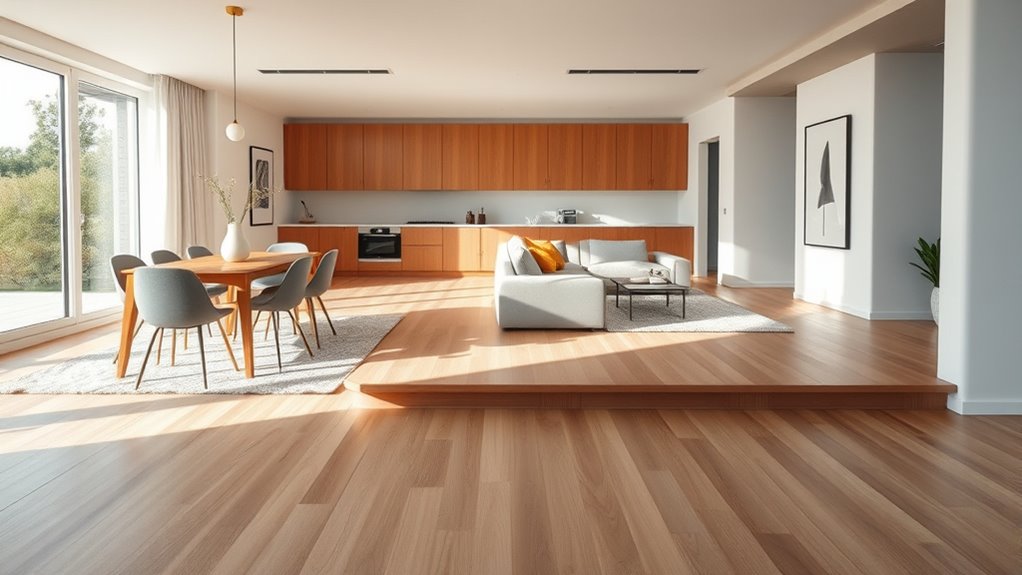
Implementing floor level changes offers a subtle yet effective way to distinguish different zones within an open-plan space. By adding low steps, sunken areas, or slight elevation shifts, you create physical distinctions that enhance spatial separation without enclosing the area. Using contrasting flooring materials or patterns at these progressions provides clear visual cues, making each zone recognizable at a glance. Elevating or lowering sections of the floor defines functional areas like dining, living, or sleeping zones while maintaining an open feel. Gentle slope transitions or partial floor elevations also add architectural interest and depth to your design. These physical cues serve as tactile and visual boundaries, subtly guiding movement and helping you organize open-plan layouts with clarity and style.
Enhancing Privacy With Decorative Screens and Partitions
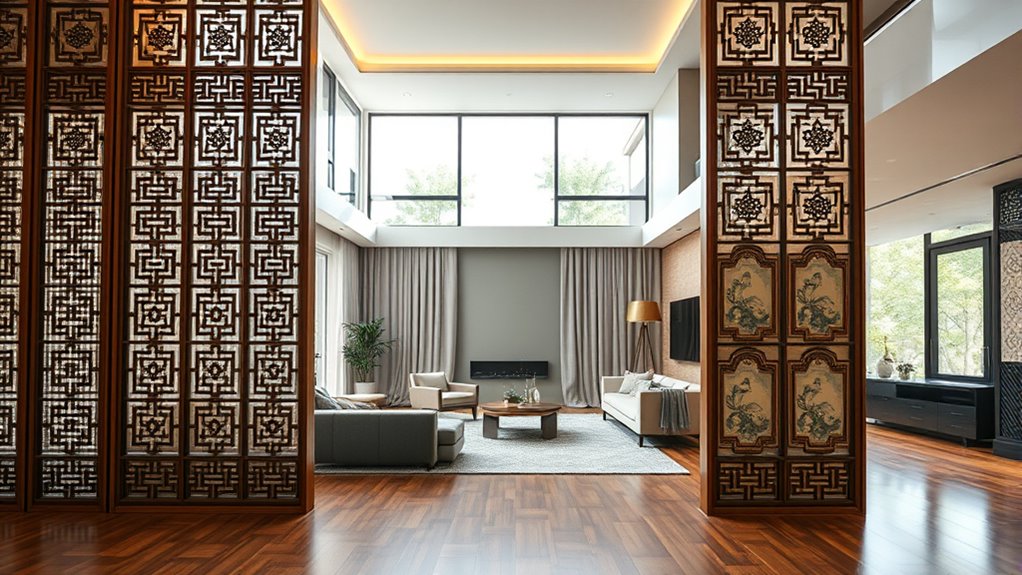
Decorative screens and partitions offer stylish, flexible ways to create privacy without permanent walls. With options like folding screens, bead curtains, or lattice panels, you can match your decor and easily reconfigure your space. Their portable design helps you define zones and reduce noise while maintaining a seamless look.
Stylish Screen Options
Looking to add privacy and define separate areas in your open floor plan? Stylish screen options, like decorative screens and room dividers, are perfect for this. They offer flexible privacy solutions that can be moved or reconfigured easily. Materials such as woven rattan, painted wood, or metal with cut-out patterns add visual interest without blocking natural light. Freestanding decorative screens can also feature artwork, mirrors, or fabric panels, boosting aesthetic appeal while subtly separating spaces. Folding screens come in various sizes and designs, allowing you to customize them to match your interior style. These partitions help create distinct zones—like a cozy reading nook or private workspace—without the permanence of walls. Their versatility makes them an essential tool for transforming your open floor plan.
Portable Privacy Solutions
Ever wish you could quickly create privacy or redefine spaces in your open floor plan? Portable privacy screens and room dividers are perfect for this. They’re versatile, lightweight, and easy to move, allowing you to set up temporary or semi-permanent zones effortlessly. Decorative screens made from wood, fabric, or metal not only block sight lines but also add style. Customize them with patterns, colors, or artwork to match your decor. These solutions are ideal for small spaces or studios, providing privacy without permanent changes. Use them to carve out a private workspace, cozy reading nook, or sleeping area on demand.
| Purpose | Benefit |
|---|---|
| Space zoning | Flexible, quick adjustments |
| Privacy enhancement | Reduces noise and sightlines |
| Style customization | Complements decor seamlessly |
| Portability | Easy to move and reconfigure |
Seamless Design Integration
Integrating decorative screens and partitions into an open floor plan allows you to create functional zones without sacrificing the sense of spaciousness. These architectural features provide visual separation that enhances privacy while preserving flow. You can choose materials like bead dividers, Murano glass chains, or fabric curtains to add style and versatility. Movable folding screens and open shelving units give you flexible zoning options, effortlessly adapting to your changing needs. Strategically placed decorative partitions balance social interaction with privacy, transforming a large space into distinct, multifunctional areas. By seamlessly blending form and function, you elevate your design, making every zone purposeful yet cohesive.
- Stylish materials that complement your decor
- Partial walls for subtle separation
- Movable screens for adaptable privacy
- Decorative screens as visual focal points
- Flexible zoning for social and work areas
Combining Multiple Techniques for Cohesive Zoning
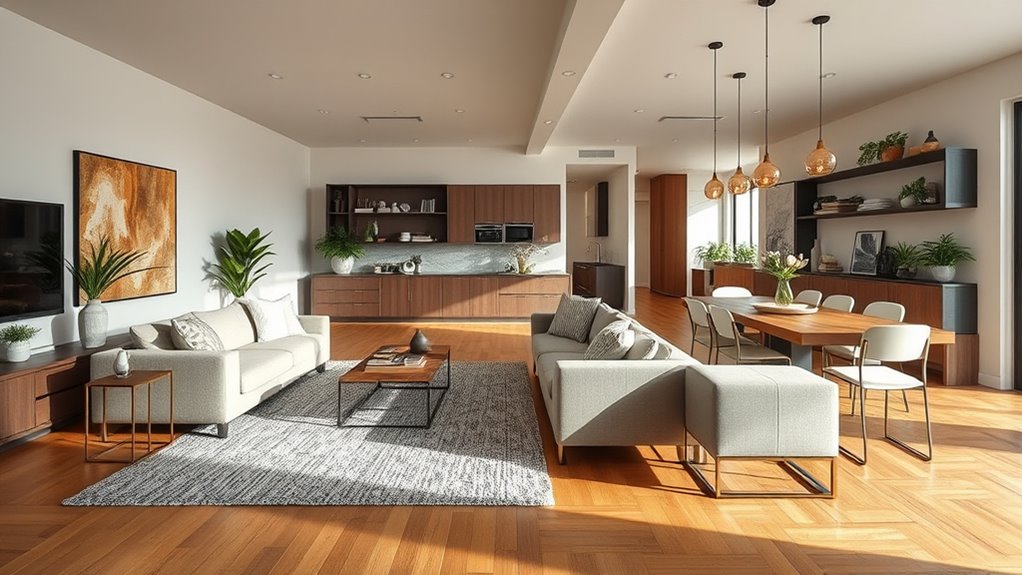
Combining multiple zoning techniques in an open floor plan allows you to create distinct yet harmonious areas that serve different functions without sacrificing the overall sense of spaciousness. You can define zones through visual cues like contrasting flooring, wallpaper, or lighting, which clearly differentiate spaces. Layering these techniques—such as adding partial walls, furniture arrangements, or structural elements—enhances clarity while maintaining openness. Consistent decor themes across zones unify the design, making each area feel connected yet purposeful. By thoughtfully integrating these methods, you establish a balanced environment that feels spacious, inviting, and functional. This approach guarantees each zone is clearly defined without creating visual clutter, enabling your open floor plan to be versatile and cohesive.
Tips for Maintaining Open Space While Establishing Clear Areas

Maintaining a sense of openness while defining separate areas is achievable with thoughtful planning. To effectively define and create zones, use large area rugs to visually separate spaces without adding physical walls. Arrange furniture, like sofas and chairs, to create natural boundaries and focal points for each zone. Incorporate overhead or pendant lighting to subtly distinguish different areas and enhance their purpose. Utilize subtle floor level changes or contrasting flooring materials at transition points to physically and visually separate zones while keeping the space open. Decorative elements such as artwork, bead curtains, or structural features serve as visual cues, helping to clearly define zones without sacrificing an open feel.
Create distinct zones using rugs, furniture placement, lighting, and decorative elements to maintain an open, inviting space.
- Use large rugs to define zones
- Arrange furniture to create natural boundaries
- Incorporate lighting to visually separate areas
- Utilize floor level changes or contrasting flooring
- Add decorative elements as visual cues
Frequently Asked Questions
How Do You Zone an Open Plan Space?
To zone an open plan space, you can start by arranging furniture to create distinct areas, like a sofa grouping for the living room and a dining table nearby. Use rugs to define each zone, and add lighting or color variations for visual separation. Incorporate open shelves or curtains to add flexibility, and consider floor or ceiling treatments to enhance the sense of separate spaces while keeping the open feel intact.
How Do You Zone a Floor Plan?
Imagine your floor plan as a blank canvas waiting for art. You paint distinct zones with rugs, furniture, and color contrasts, creating visual borders that define each space. You can carve out areas with lighting and ceiling treatments, like adding highlights to certain sections. Multi-functional furniture acts as your brushstrokes, flexible and easy to move. With these techniques, you craft a harmonious, well-zoned space without losing the open feel.
How Do You Separate Areas in an Open Floor Plan?
To separate areas in an open floor plan, you can use large rugs or carpets to define spaces visually and physically. Arrange furniture to create natural boundaries, like grouping seating for different zones. Add visual dividers such as open shelving, screens, or bead curtains that let light through. Use contrasting flooring or colors at junctions, and layer lighting to highlight each area, making your space feel organized and functional.
Will Open Floor Plans Go Out of Style?
Think of open floor plans as a lively river, flowing freely but sometimes needing gentle bends to stay interesting. You’re likely wondering if this style will go out of fashion. The truth is, open layouts still flow with popularity, but smart zoning acts like those bends—adding structure without restricting movement. So, your home will evolve, blending openness with subtle divisions, ensuring it stays fresh and functional for years to come.
Conclusion
By using these zoning tricks, you can transform any open floor plan into a functional, stylish space. Did you know that homes with well-defined zones can increase perceived square footage by up to 25%? So, don’t be afraid to get creative with furniture, rugs, lighting, and partitions. With these simple strategies, you’ll create distinct, inviting areas that enhance both privacy and flow—making your open concept truly feel like home.
